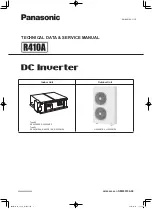
OPERATION
Page
58
Copyright
Trace Engineering Company, Inc.
5916 - 195th Street N. E.
Arlington, WA 98223
Telephone: 360/435-8826
Fax: 360/435-2229
www.traceengineering.com
SW Series Inverter/Charger
Part No. 2031-5
Rev. B: Sept 1, 1999
Figure 18, Trace SW Series Inverter Output Waveform
The inverter is able to synchronize with other AC sources before connecting it to the AC load. The
frequency of the AC source is tracked and the inverter constantly adjusts its frequency to maintain a lock.
A normally open contactor is used to parallel the inverter’s output and the AC source.
The inverter’s power topology is bi-directional. If the waveform created by the inverter has a higher voltage
than the paralleled AC source, then power flows from the batteries to the load. If the waveform generated
has a lower voltage than the AC source, power flows from the source to the battery. The various modes of
operation use different algorithms for determining the size of the waveform to be created by the inverter. In
battery charger mode, for example, waveforms smaller than the AC source are created to cause current to
flow into the batteries. This process is fully regulated to provide a three-stage charge cycle. If the level of
AC current exceeds the user programmed generator or grid size, and then the inverter will switch to a
generator support mode and create waveforms that are larger than the AC source. This causes power to
flow from the batteries to the AC loads to prevent overloading of the AC source.
In utility inter-active mode, the inverter can operate as a battery charger or paralleled AC source to the
utility grid. If an external source such as solar panels attempts to raise the batteries above the float voltage
setting, the inverter will try to hold the battery voltage at the float voltage level by “selling” the excess
power into the utility grid. This is done by increasing the inverter’s output voltage level. This moves the
excess DC power from the solar array to the AC utility grid, preventing the battery from being overcharged.
If the utility grid connected to the inverter is de-energized, the inverter can not regulate the battery voltage.
Some external control device, such as Trace C40 Load/Charge controller, must be provided to prevent
damage to the battery.
Summary of Contents for SW II - REV 4.01
Page 151: ......
















































